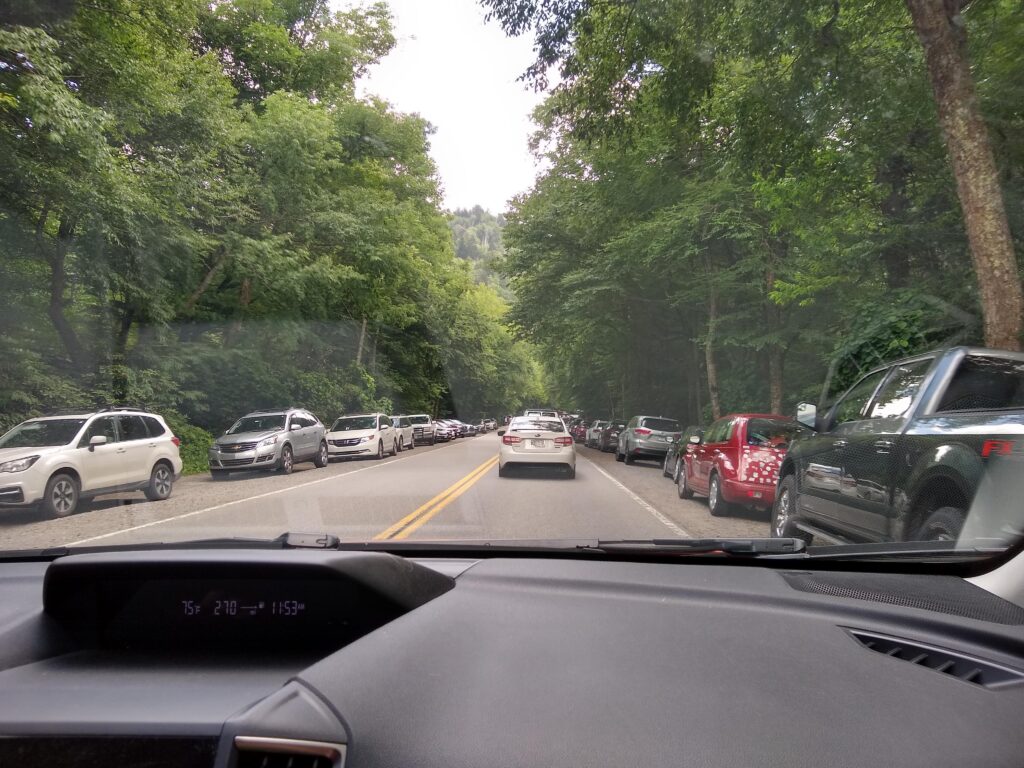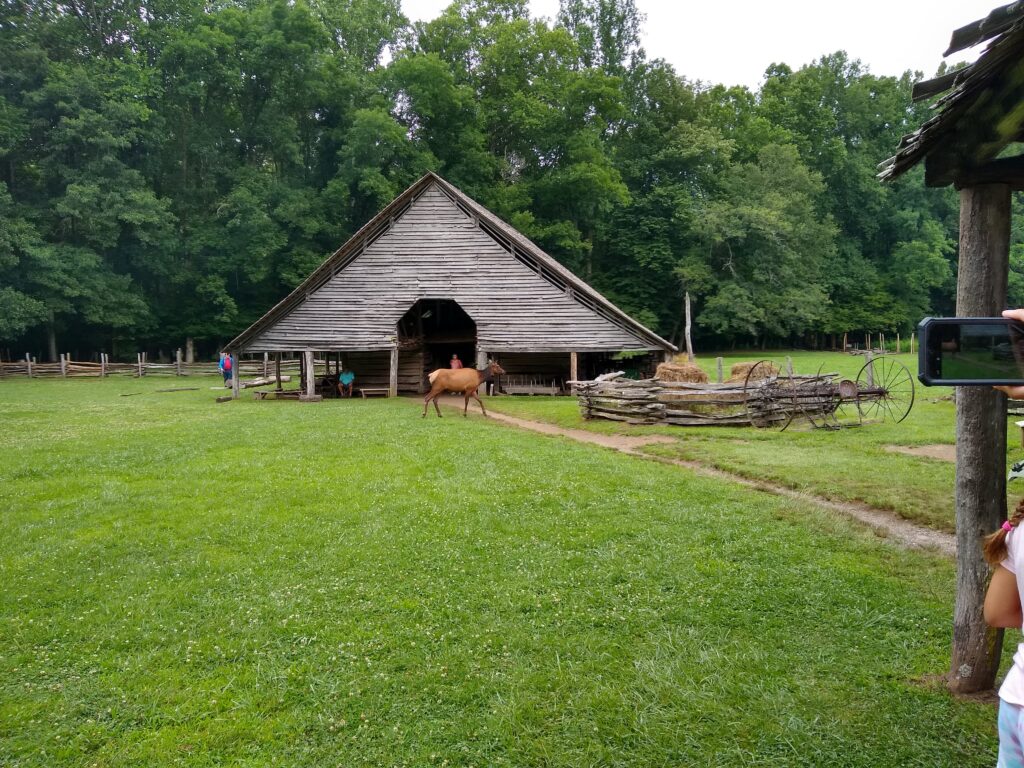Dealing With Crowds in Pigeon Forge, Gatlinburg, and Great Smoky Mountains National Park
Rachael also contributed to this post.
If you’ve ever considered going on a trip to the Smokies — including Pigeon Forge, Gatlinburg, and Great Smoky Mountains National Park — you’ve probably wondered if it’s crowded … and, if so, how to best deal with those crowds.
We’ve experienced it, so we can tell you.
First, let’s get this out of the way: the entire area is busy, especially in the summer months.
Each area in the Smokies has its own challenges. Pigeon Forge is a tourist-trap spectacle, with a dizzying collection of kitschy neon-glow attractions, restaurants, and hotels. It has a multiple-lane main road and a number of four-lane side roads, but they swell to capacity during peak hours. Traffic jams are common, bottled up by a combination of traffic lights and turn-around lanes spread along the main parkway that leave cars waiting to sneak into an open spot. Shortcuts don’t help much, and side-roads can get as packed as the main parkway.
Gatlinburg, meanwhile, has a more rustic feel, with cozier architecture set against the mountains. The roads in Gatlinburg are narrower and have more traffic lights than Pigeon Forge, and, like Pigeon Forge, quickly get crowded. Gatlinburg also has a large pedestrian crowd during peak times. (Both cities seem roughly equally crowded on an average summer day.)
As for the National Park? There are pull-offs and parking lots all across the park, but they quickly fill up, especially near popular trailheads. If you want to hike anywhere with a waterfall, there’s a good chance you’ll have to park a distance from the trailhead, especially during the busy times. At one point we drove 5 miles down a remote gravel road to a waterfall trail, only to find cars everywhere.

In short, this area is more than just crowded in the summer: it’s honestly overcrowded. Many attractions and restaurants struggle to properly service the crowds. If you want to go to the area, bring your patience with you … and if you can’t do that, consider coming back in the winter or going somewhere else entirely.
What if you’re insistent on coming? Then what?
Here’s what to do.
Tip 1: Avoid Weekends
You might take this to mean that weekdays are good. They’re not. Monday-Friday are crowded during the summer, especially July and August. You’re not going to escape that.

But weekends are on a whole other level. People pour into the Smokies on Friday and Saturday, and traffic goes from slow to a near dead-stop. The roads from north of the region are a steady flood of incoming tourists, and getting anywhere is a logjam. Eating out, which is difficult during the afternoon or evening on a weekday, is just about impossible on Friday or Saturday night.
So if you want overcrowded instead of over-overcrowded, aim for weekdays.
And don’t even think about holidays.
Tip 2: Get out early.
Across the region, early is best. Traffic between 6-9 a.m. is much quieter than it is from 10 a.m. onward. By noon, the roads in both Gatlinburg and Pigeon Forge are packed, in-city travel time doubles, and it stays that way until well after dark. If you can get out the door earlier in the morning, you’re going to get where you need to much faster than if you decide to sleep in.

Likewise, if you want to visit an attraction, your best bet is to get there right when it opens. For example, we toured the Titanic Museum in Pigeon Forge and Anakeesta in Gatlinburg. Both opened at 9 a.m., and in both cases we got there right at opening. Not only did we have less traffic to deal with getting to both destinations, but we we were able to find parking and get in easier than we would have later on in the day. The same went for Cades Cove in the park, which we arrived at close to its 8 a.m. opening time.

While traffic in most of the national park isn’t bad early in the morning, parking lots fill up in the park earlier than they do in Pigeon Forge or Gatlinburg. If you arrive at one of the park’s trails at 9 am, you’re going to have trouble finding a nearby spot. Your best bet for hiking, then, is earlier, like 6 a.m. or 7 a.m., or earlier if you can manage it because some family members in our group said parking was fairly full even at 7 a.m. The same goes for Clingman’s Dome, which has a lot of parking but can fill up during the day despite being deep in the park.
Tip 3: When it Comes to Meals, Think Outside the Box
Restaurants are crowded during lunch and are brutal at dinner. There are some ways around this.
One is to eat at nontraditional times. You’re going to have a much easier time getting a seat and getting served if you eat at 3 p.m. than you will at noon or 5 p.m. One exception is the dinner shows — Dixie Stampede, the Pirate’s Voyage, Hatfield and McCoy — which are busy and play to a full house no matter when you go. Other places, though, are easier to get into.

Two, look at more dinner-oriented places for lunch. We observed that steak restaurants such as Texas Roadhouse and the like, which are packed at dinner, were less crowded at lunch. You might check that out.
Three, think about buffets. You don’t have to wait for a waiter to bring you food, so you can get to eating faster. There are several buffet restaurants, especially in Pigeon Forge.
Four, be willing to hit up fast-food or grab something from a local grocery store. They’re maybe not as exciting as other local eateries, but if you are tired and hungry, they’re there. Most grocery stores had ready-to-eat food options such as sandwiches and salads. One grocer we stopped at had a full deli that advertised fried or rotisserie chicken, but it was shut down for the evening, and other people in our family group saw the same thing at another grocery store in the area, which caused us to theorize that those options are probably popular and may sell out early for the day. Another option if you’re staying in a hotel room with a microwave: don’t hesitate to pick up tv dinners and have dinner in one night; our kids had fun being turned loose in the freezer aisle to pick out their own meal.
Tip 4: When Possible, Pre-Buy Tickets and Make Reservations
Thinking ahead helps a lot. Many of the big-name places offer online tickets and reservations. This saves you potentially waiting in a ticket line and may come with other perks. At Anakeesta, for instance, if you buy an express ticket online you can bypass the ticket counter and go straight to an express line to the lift. The downside is that you have to take the open ski lift chairs rather than an enclosed gondola or road vehicle (the ridge rambler), and you can’t get discounts that you could at the ticket counter, like AAA. But if you really want speed, there is no faster way up, especially later in the day. (Of note: our family wanted the AAA discount and more flexibility on how to go up, so we instead arrived first thing in the morning. We had to wait a little while for tickets, but not nearly as long as we would have two hours later.)
Buying ahead of time also has the benefit of making sure you get in. We went to both the Titanic Museum and the Pirate’s Voyage theater, and both were completely booked when we arrived, even though we got to both early. Fortunately, we had pre-purchased tickets for both, so it wasn’t a problem.

A final note: as with Anakeesta, buying early at other places won’t necessarily save you money. We found coupons for local attractions when we arrived at the Tennessee Welcome Center on the interstate and later when we got into town, including some coupons at our hotel’s front desk. In theory, those might have saved us money over buying early. But they had to be used in person, which isn’t good for much if the places are sold out. We concluded that the speed and certainty of buying early was worth it.
Tip 5: Consider less-hyped areas.
Most people who come to the region either stay in Gatlinburg or Pigeon Forge, which is why those areas are so crowded. But there are other areas in orbit around the national park that are not as busy. You’ll lose some of the big-name attractions, but you also gain a more relaxed experience.
Townsend, Tennessee, is located about 22 miles west of Gatlinburg and about 18 miles southeast of Pigeon Forge. It doesn’t have as much to offer as the two bigger cities, but it does have a nifty collection of things to do. For example, there is a very nice cave tour at Tuckaleechee Caverns (we still recommend getting there early because the parking lot went from empty to full while we were on the first tour of the day), and there are several places to eat or hit the water. The town is noticeably quieter and much, much easier to navigate, with very little in the way of traffic. Better still, Townsend is close to Cades Cove, one of the more popular attractions in the national park. Townsend is also reasonably close to Pigeon Forge, although getting to Gatlinburg from Townsend is harder, thanks to more winding roads.

Cherokee and Bryson City, both in North Carolina, are located on the south side of the park. They’re 40-50 miles from Pigeon Forge and Gatlinburg, so they don’t make for great hopping-off points for the north side, but they have their own things to offer. Cherokee, for example, has Native American heritage sites, while Bryson City has several places to eat. Both are close to the Mountain Farm Museum on the park’s southern end, where you can tour old buildings and, at certain parts of the day, spot elk.

Closing Thoughts:
The area around Great Smoky Mountains National Park is one of the most popular places in the eastern half of the United States, and the hub of that activity is in the cities of Pigeon Forge and Gatlinburg. They can be crowded and difficult places to navigate, especially from noon onward and on weekends. Fortunately, there are some hacks that can make your life a little easier. You’ll still have to deal with the reality that the area is overtouristed and, at times, seemingly overmatched by how many people come to visit. But if you’re willing to be creative — and be patient — you can still make some good memories. We did.







